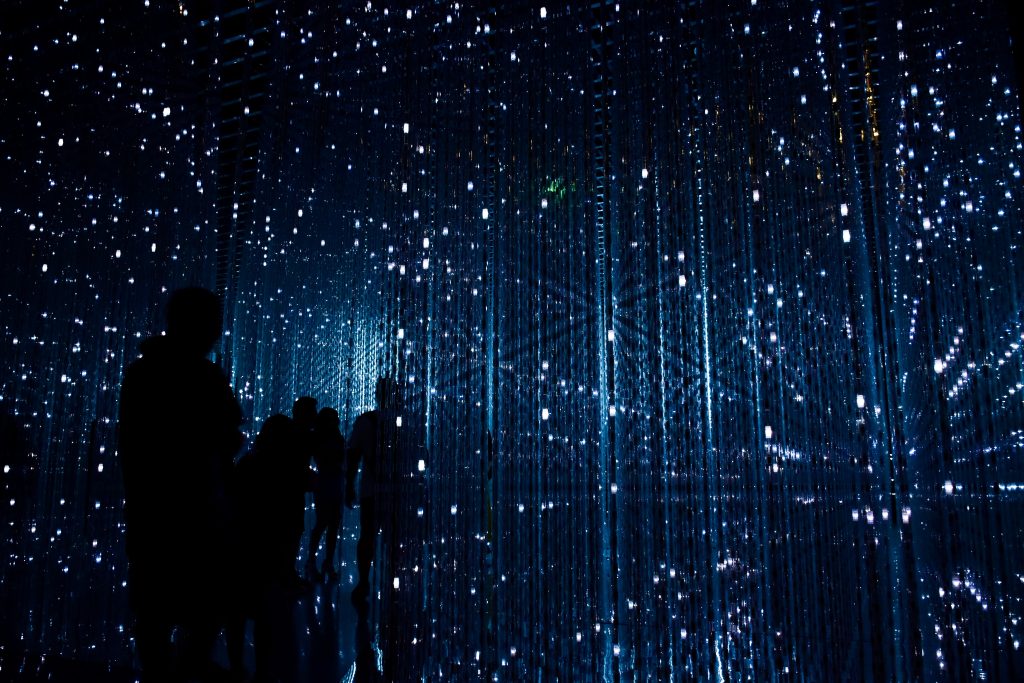In Campfire 6, we were taught a handy lesson about relinquishing control and handing over the reins to our participants, resulting in a conversation that was far more unexpected – and dare we say, transformational – than we could have designed.
Coupled with Mat Duerden’s brilliant article, this left us pondering an intriguing question: is it even possible to design for transformation?
Over the course of Campfires 1-6, two core components of experience design have repeatedly emerged: co-creation and transformation.
“Transformations are the highest form of experience. We go from memorable to meaningful and end with transformation.”
James Wallman, Founder, The WXO
WXO Founder James Wallman reminded us of this hierarchy of experiences, with transformation sitting pretty at the top. Joe Pine sets out the importance of transformation as the next economic offering in the book that kicked it all off, The Experience Economy. In his view the customer is the product, something Aga Szóstek also explores in her book, The Umami Strategy.

But while we might all agree that transformation is the holy grail of experiences, the question of how we trigger it remains unanswered. We discussed in Campfire 5 how, as opposed to a service, an experience has to be co-created – so perhaps when it comes to transformation, you can lead a horse to water, but you can’t make it drink.
With participants including Paul Bulencea in Ecuador and Nasya Kamrat in Portland, Joe Pine in Minnesota and newbies Dallas Burgess in Atlanta and Annette Mees in London, our Founding Circle came together to tackle the dilemma of how experience designers can create a pathway – or several – to the water.
What we talk about when we talk about transformation
Paul Bulencea of the College of Extraordinary Experiences started us off with an excellent leveller: what do we actually mean when we say “transformation”?
“If you say you’re transforming, it means you’re moving from one state to another. It feels big.”
Colin Shaw, CX pioneer
However, perhaps this idea of transformation as a “big” doesn’t tell the whole story.
“We always think of transformation as these major, massive moments, but actually it can be small or incremental. This changes what designing for it means – it could mean allowing for a change of perception that leads to a big transformation, but through incremental moments.”
Nasya Kamrat, Founder, Faculty
Nasya introduced the idea of “small t transformation” and “capital T Transformation”. It’s hard to design Transformation for more than one person, but smaller transformations might be triggered on a wider scale and over a longer timeframe.
“Memory is imperfect. It’s the change in narrative. Two people can walk away from the same experience with singular memories – so how can we design the experience so their transformation continues a year later?”
Nasya Kamrat, Founder, Faculty
Sheena Patel picked up on this difference in designing for micro and macro transformations – what Paul calls covert and overt transformations.
“When it comes to transformation, there isn’t one size fits all. Sometimes it happens in the moment, and sometimes it’s when you look back.”
Sheena Patel, Founder, YonderBeyond
When does transformation take place?

This idea that transformation is often something that happens after an experience became a crucial one.
“Are we saying that transformation doesn’t happen at the heightened moment; it happens in reflection? And does this mean there’s a tension between peak-end theory and allowing that space for decompression or denouement?”
James Wallman, Founder, The WXO
Mat Duerden jumped in with a slide illustrating the importance of the transition in and out of experiences.
Memorable experiences are connected to emotion; meaningful experiences are connected to discovery about yourself and the world around you; and transformative experiences are about change. For “small-t” transformation this can mean a narrative change that can happen in the moment; but for “big-t” Transformation this means a change in identity, which is most likely to take place over time.
“People think about transformation far too simply. Experience design up until now has been primarily about participation, but this co-creative reflection stage is the one in which I’m most excited to see innovation take place.”
Mat Duerden, experience design educator
Colin Shaw agreed that we underestimate the importance of memory and looking back on an experience.
“The biggest thing I’ve learned is that we don’t choose between experiences; we choose between the memory of those experiences. It’s what people say the next day that counts – so we should focus not on the expeience, but on the memory.”
Colin Shaw, CX pioneer
(This reminds us of Dorothy di Stefano’s point in Campfire 6 that you should design not for emotion, but for conversation.)
How to design space for reflection

This posed the question: if the time to reflect upon an experience is where “big-t” Transformation takes place, how can experience designers create this space for reflection – even if the transformation might not happen until a year down the line?
“You can’t prepare for a transformation, because you can’t understand it until you’re there. It’s like becoming a parent: no matter what you read, you won’t get it until you are one.”
Joe Pine, author, The Experience Economy
According to Neil Lundberg, it’s important to design this space for reflection both for the individual and groups. He gave the example of virtual meetings, which often end abruptly, and talked about how for a recent virtual graduation there was an additional 20-minute space for free-flow socialising after the meeting had officially ended. (Brian Hill added that this reminded him of what was missing in Swamp Motel’s The Kindling Hour – read his full review here).
Sheena talked about how she always creates a “decompression space” when designing experiences.
“It’s the punctuation at the end of an experience where the custodian who took you through it facilitates some time for reflection. We also create touchpoints throughout the experience that encourage people to take their own personal journey of transformation, and remove barriers to them having those moments.”
Sheena Patel, Founder, YonderBeyond
What, so what, now what?

UX pioneer Joe McLeod chipped in with Borton’s development framework, which uses a nifty “What, so what, now what?” series of questions to develop experiences:
- What?: what happened during the experience?
- So what?: what does it mean?
- Now what?: what are the consequences?
According to Joe, we’re very good at the first two, but less good at the third – the reflection.
Film writer, director and producer Dallas Burgess applied this framework to the world of movies, where “reflection is everything”.
“Nothing is worse than leaving a theater after being transformed in some capacity… only to walk into a concrete parking lot. It’s a buzzkill. We’re exploring creating a ‘spoiler bar’ set in the world of the film you’ve just watched, where you can discuss what you’ve just experienced.”
Dallas Burgess, Co-Founder, Metamorphosis Experiential
James asked if some experiences have an advantage when it comes to reflection as they have a greater number of touchpoints – for example, an app you use every day will have a stronger connection that a weekend in Miami.
“But tech can be used everywhere. If people think an experience is curated for them, 75% of them will choose to opt in – so people will opt in to tech if it feels important or helpful to them.”
Nasya Kamrat, Founder, Faculty
Don’t stage an experience: guide it

Whether or not you create a space for reflection, your audience has to want to engage with it. Again, you can take a horse to water, but you can’t make it drink – or in the words of Bob Rossman, “some people don’t want to be transformed”.
The solution? Understanding the direction your audience – not you – want to go in, and guiding them to discover that path. You need to understand their motivations to sell them the idea.
“Transformation can’t be staged; it has to be guided.”
Brian Hill, experience design professor
Dallas brought up “the Inception model” – you can’t tell someone how, when or what to transform, but have to allow them to progress at their own pace.
“You’re creating a groundwork so people can put their own experience into it – they are more likely to be receptive to transformation than being told something is transformative. People are going to apply their own experiences to something regardless – so create something that allows them to do this.”
Dallas Burgess, Co-Founder, Metamorphosis Experiential
Or according to Joe Pine:
“Companies want to transform people into loyal customers, but that’s not what their audience wants. Use a diagnosis tool to understand the direction of what your audience wants to become, then design experiences for that.”
Joe Pine, author, The Experience Economy
However, Colin pointed out a fatal flaw in asking people what they want: what they say and do are often different things. Therefore you have to understand both their conscious and subconscious motivations.
For Paul, the solution lies in having a “guide” who can do this diagnosis and recognise which of the person’s aspirations come from trauma, and which are true to human nature.
“Looking at psychedelic integration in the organisation MAPPS, guides are trained in the idea of WAIT: Why Am I Talking? This recognises that as a guide, you’re creating an expanded state of consciousness for the participant in which you don’t need to say anything. You just need to hold that magic circle and liminal space in which they can dissolve their ego and allow things to surface from the unconscious. Then the real work starts with the participant starting a practice of daily rituals to cement this new way of being.”
Paul Bulencea, CEO, College of Extraordinary Experiences
Martin Coat also talked about this time for reflection as “holding space”, putting forward the idea that perhaps transformation isn’t found at the heightened moment of euphoria, but afterwards.
“We must remember that no one person is the same. I can’t design someone’s transformation, but I can design their path to the water. It’s like dropping pebbles in a pond and creating ripples – I’ll never know if or how it unfolds.”
Martin Coat, immersive theatre expert
Dallas pointed out that this reflection period can take years, and the effects can change over time.
“If you re-watch a film a decade later, you might perceive it completely differently because you have changed. When we design meaningful experiences, we’ve got to be careful that what we create allows for that subjectivity to live so that it can live forever.”
Dallas Burgess, Co-Founder, Metamorphosis Experiential
Beware of pseudo transformations!

Sheena talked about how when we’re thinking about transformations, we have to be careful not to fall into the trap of commoditising and designing “pseudo transformations”, instead focusing on “purpose-driven design”.
“Having just lived through this shared crisis, do we have a responsibility to facilitate more meaningful introspection and transformation in our peers and communities?”
Sheena Patel, Founder, YonderBeyond
How do we measure transformation?

Another challenge of designing for transformation over a period of reflection is that it’s very hard to get metrics on or even define.
However, Aga suggested that you can measure the transformation if you collect someone’s narrative before and after their experience, as she does in her book.
“You ask them if the narrative have changed. It’s expectation versus memory.”
Aga Szóstek, author and strategic experience designer
Paul suggested some other ways he’s come across for measuring transformation. One is the Mystical Experience Questionnaire on website Trippingly.com. This is for people who have taken psilocybin to measure how the trip transformed them. Another is AWE-S scale, which measures the peak experience, awe.
The WXO Take-Out

In the spirit of co-creation and allowing transformation to come from reflection, this week we’re handing over our Take-Out to our participants, who told us their top takeaways.
“The answer to the original question of “can I design transformation?” is no. I can own 95% of the “what” will happen, 60% of “why” it happened, but very little of the “what will happen next”. That’s purely down to the individual in the experience.”
Martin Coat
“Transformation needs to be defined. People say transformation in business without understanding what it really means.”
Colin Shaw
“Transformations are co-created, guided, and require time and reflection.”
Mat Duerden
“‘We don’t choose between experiences, we choose between memories’ is so powerful, but memories are also imperfect and individual. So how do we curate experiences to elicit the type of memories that we want a participant to walk away with?”
Nasya Kamrat
“It’s important that the subjects of your design want to be transformed. Motivated participants seeking transformation make the puzzle easier to solve.”
Bob Rossman
“Transformation is not a singular moment – it’s moving from who you are to who you will be. It’s our job to provide the guide, create the touchpoints, and remove any barriers towards that.”
Nasya Kamrat
Interested in taking part in discussions about experiences and the Experience Economy? Register your interest in becoming a member here to be the first to know about upcoming WXO events, both digital and IRL.






